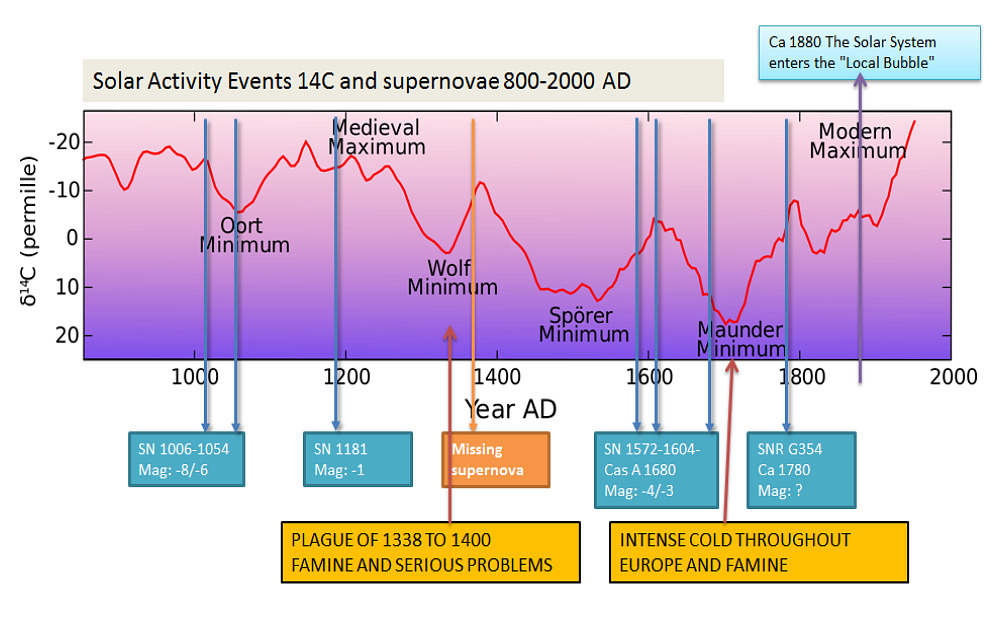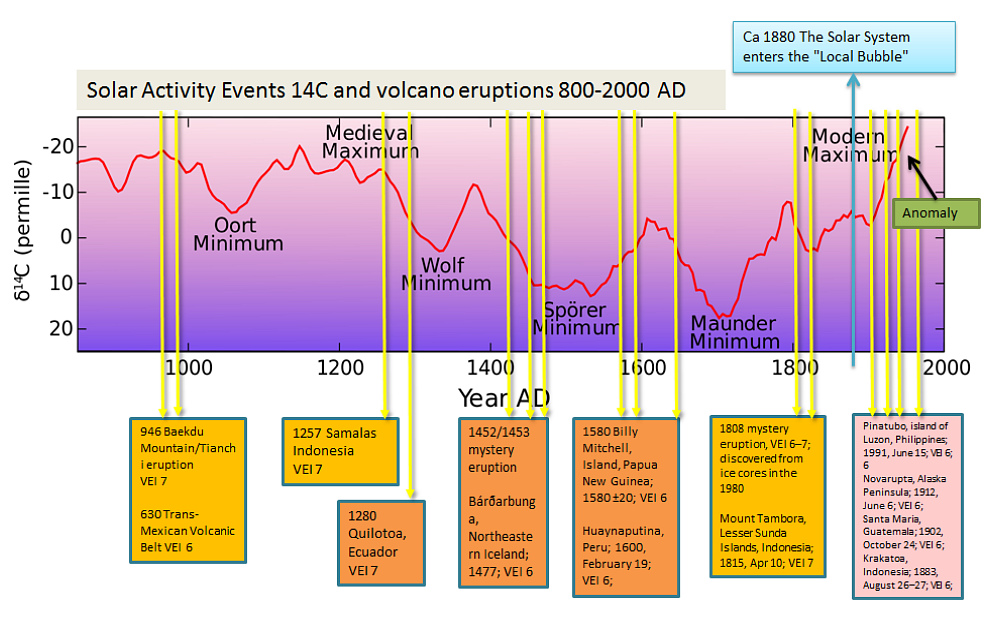Supernova prediction method
Effects of a supernova on the solar system
Just as I explained on the “evidence” page, the radiation of a supernova affects all solar systems that are in the “vicinity” of the cosmic cataclysm. Obviously the closer they are, the more they are affected.In fact, if there is a light source, a lighthouse, very far away it doesn't bother our eyes, but if we position ourselves right in front of the light beam it can even blind our sight.
In the case of supernovae (and also Novae), however, it is not only the light source that makes them visible but, a source that our eyes do not see and do not perceive (if their flux is weak), is the one that has the greatest influence. among the solar systems in the galaxy. This radiation is called “cosmic rays”.
We have analyzed how the latter influence in all the previous pages, even rays arriving from very far away can cause earthquakes and volcanoes on all the planets of the solar system. Even if the light from the supernova to the naked eye does not cause any problems to the eyes (be careful, however, that if you stare at a supernova with a magnitude greater than -2 it can damage the retina because it emits X-rays and Gamma rays) and does not cause anything serious to none on earth, however CR (cosmic rays), being electrically charged particles, significantly influence all planets.
Of course, not only the planets, but also on the Sun. Someone might think: but what can some particles do to the Sun which is so large, they certainly don't do anything to it. Of course, a particle has nothing to do with the Sun but, since the Sun is much larger than all the other planets, the flow it receives is proportionally larger.
If we looked at the light of the lighthouse, which I was talking about before, with a telescope, Mount Palomar for example, with the naked eye, even if it blinds us from afar. Why? Because Mount Palomar has a 4 meter lens (mirror) and our eye, the pupil is measured in millimetres. Thus the Sun receives a “dose” thousands of times larger from a Supernova than other planets.
But the relationship is not given by the size of the celestial body, that is, the Sun or the Earth or Jupiter, but rather by its magnetic field. So the size of the Earth's magnetic field, which is much larger than the Earth will receive many more particles. The Sun's magnetic field extends across billions of kilometers, or hundreds of astronomical units.
So if a supernova affects planets, stars like the sun then we need to understand well what a supernova does to a star. Below is the graph of sunspots over time and exploded supernovae visible from the earth and volcanic eruptions.
Effect of a Supernova on other stars
We have seen in the previous pages that when the Sun was hit by radiation from a supernova, it immediately decreased its irradiance. For example, during the “Manunder Minumum” the solar cycles almost disappeared. But what would happen if this same radiation hit a dying star, one of those red giants that are at the end of their existence. They would certainly significantly reduce their brightness.
We can compare this situation to a boy who plays pale and takes a blow: after a few massages he recovers and plays again. But if in the boy's place there was an elderly person, perhaps 90 years old, the hospital would be insured for him.
Here the boy is the Sun and the old man is the dying red star.
Hours, let's assume that the flow was so intense that the brightness decreased for several months. No longer producing energy from its core, the dying star begins to collapse its entire outer shell towards the center. When it reaches a certain mass and density all this material that collapses in the core of the dying star, triggers a huge nuclear reaction and the star explodes.
This reasoning applies to both Type I and Type II supernovae. in Type II the core of a single star is collapsed, in Type I a double explosion occurs, first the dying star and then all the expelled material goes onto the white dwarf which in turn collapses (I realize that it is a new and unprecedented theory, that of Type I supernovae, and that many astronomers will turn up their noses, I await their answers). This is why they are generally more powerful.
Here, supernovae in the galaxy are formed like this: triggered by another supernova (or even by a Nova).
I could write hundreds of pages on this discovery which leads us to many conclusions. But I'll try to summarize in the next paragraph.
The role of the Supernovae in the galaxy
It seems to me that this discovery explains many things. First solves the paradox of the times that astronomers still sell data to this day. In fact, official science says that among the supernova candidates before exploding, with their calculations on super-computers, it always takes millions of years. If this were the case, very few would explode in the Milky Way.
Instead I explode about 3 every 100 years. With the new theory, the Galaxy would become a kind of Christmas tree where a supernova lights up another dying star. Furthermore, this theory explains how these explosions bring death but other life, because other stars and planets will then be born from the supernova.
It can still be said that indicatively a limit has been placed on any civilization. Every approximately 8000/12000 years a supernova explodes close and powerful to any other star. For example, if a civilization does not reach a certain level of knowledge or mental development within that time, it is automatically destroyed. It seems that only those who manage to have certain knowledge will be able to save themselves.
I remind you that if a nearby and powerful supernova were to explode there would be no escape for anyone, not even if we went to the Moon, not even to Mars. There would be no escape anywhere, not even underground. This would end civilization.
This reasoning leads us to another logical conclusion: if the galaxy was made like this and all galaxies as far as we know have supernovae then there are almost certainly millions of civilizations in the known universe. Millions who have passed these tests thanks to their knowledge and millions who have become extinct.
Calculation of stellar coordinates
To understand how a supernova is triggered by another supernova or how the rays of a supernova have hit the earth over time and how they will hit in the future, we need to calculate the trigonometric coordinates of the stars in the galaxy. In short, we must be able to calculate the true distances of two stars that we see in the celestial vault which is not the distance in degrees between the two stars that we see that is the true calculated distance.
To do this, unfortunately, I am not very “knowledgeable” in mathematics, that is, I really like mathematics but I don't have time to study it well, so I found this site on the web which automatically calculates the distance between two stars: neoprogramming.com .
At this point I cross-referenced all the supernovae that exploded to understand which one triggered the next supernova.
The work was very long, I will summarize it here and refer to the complete study which I will publish later. Basically I took the list of all the SNs and all the “remnants” and put them on a spreadsheet both horizontally and vertically.
In the intersection between the cells I calculated the year of intersection of the radiation of the older one with the new star.
Since we already know the explosions that occurred over the course of at least 2000 years we can ascertain whether one of the known ones crossed another known SN causing the explosion.
The results are excellent even if in the majority of cases the radiation hitting the dying star is not enough to make it collapse. Just like a boxer doesn't always knock out his opponent. It will certainly not please astronomer “scientists” to read these comparisons but they are useful to give a clear vision of what is happening.
I discovered that SN 1604 (Kepler's supernova / 8-9 October 1604 / Mag. -2.5 / Ophiuchus) was crossed by the radiation of SN 393 ( Confirmation / 27-Feb 393 / May -1 / Scorpio ) and in the year 1604 on earth we saw the consequences (Moreover this supernova together with SN1572 caused the Minimum of Mauder with dozens of years of cold on the earth).
Again, SN 1572 (Thycho Supernova / Nov 1572 / Mag. -4 / Cassiopeia) was crossed by radiation of SN 1181 (Discovered by Japanese and Chinese astronomers / 4-6 August 1181 / Mag. ? / Cassiopeia) and in 1572 it was seen by the Danish astronomer Tycho Brahe and caused in 1575 (cosmic rays travel slower than light, they arrive after) the earthquake in May 9 Chile in Valdivia and another earthquake in Mag. 9.25 in the Aleutian Islands with related Tsunami and the eruption of various volcanoes including Huaynaputina VEI6 a> which darkened the sky and caused temperatures to drop in the Northern Hemisphere.
In all the number of Sn and Remnant is 18 which approximately gives about 80 crossings. The work on can improve considerably because if we take into account the mn/max distance of each star there are 4 crossings complete with dates and at this point it is possible to discover others. My goal has been achieved for now, I can determine with this method what the next supernova could be that will mark the end of this system.
At this point, after having explained how the collapse and explosion mechanism of an supernova works in my opinion, you can read what I discovered regarding the sudden decrease in brightness of the star Betelgeuse in December 2019 where many thought (me too) that it would exploded as a supernova. I invite you to read the next chapter.





Leave a Reply